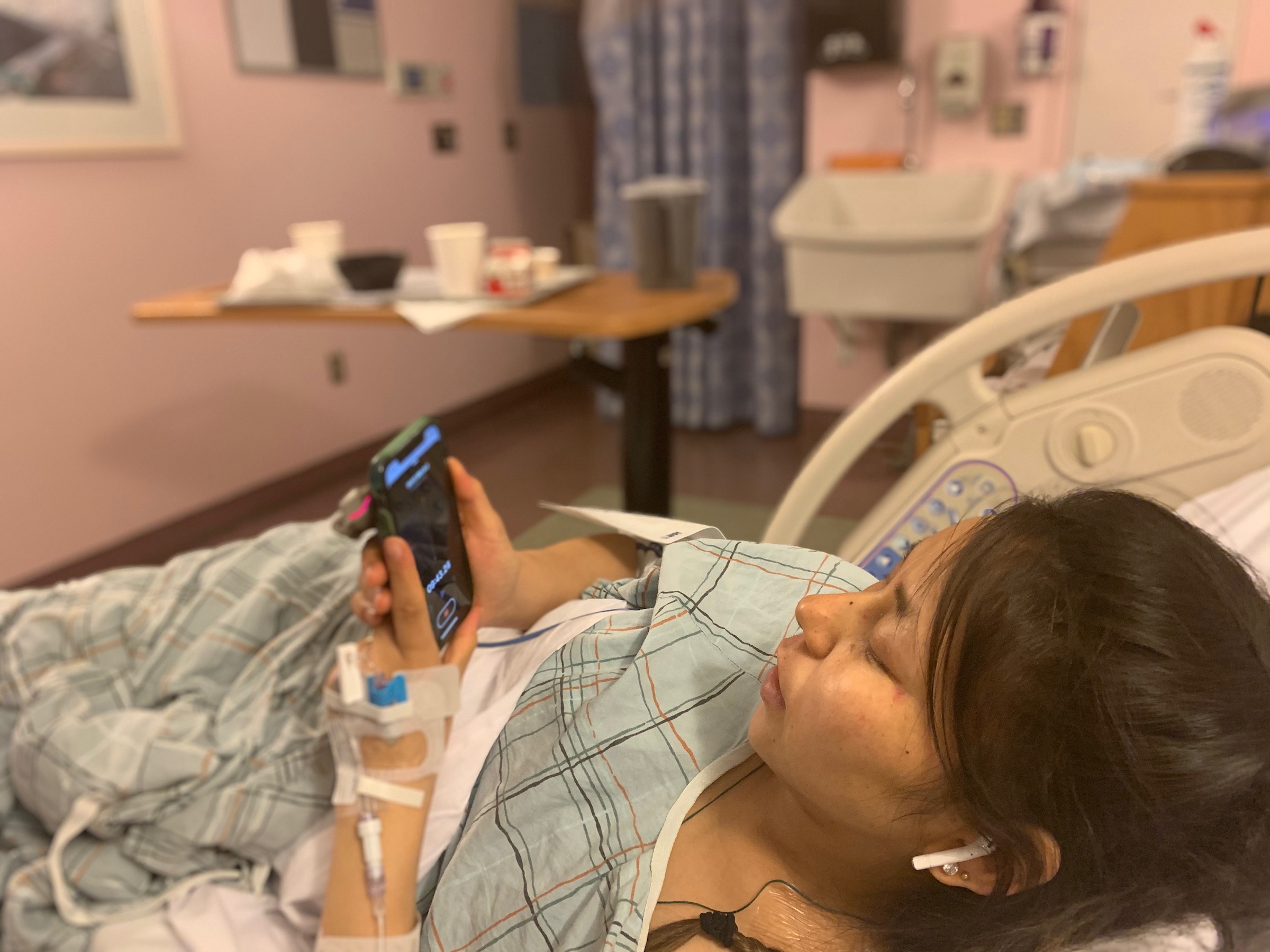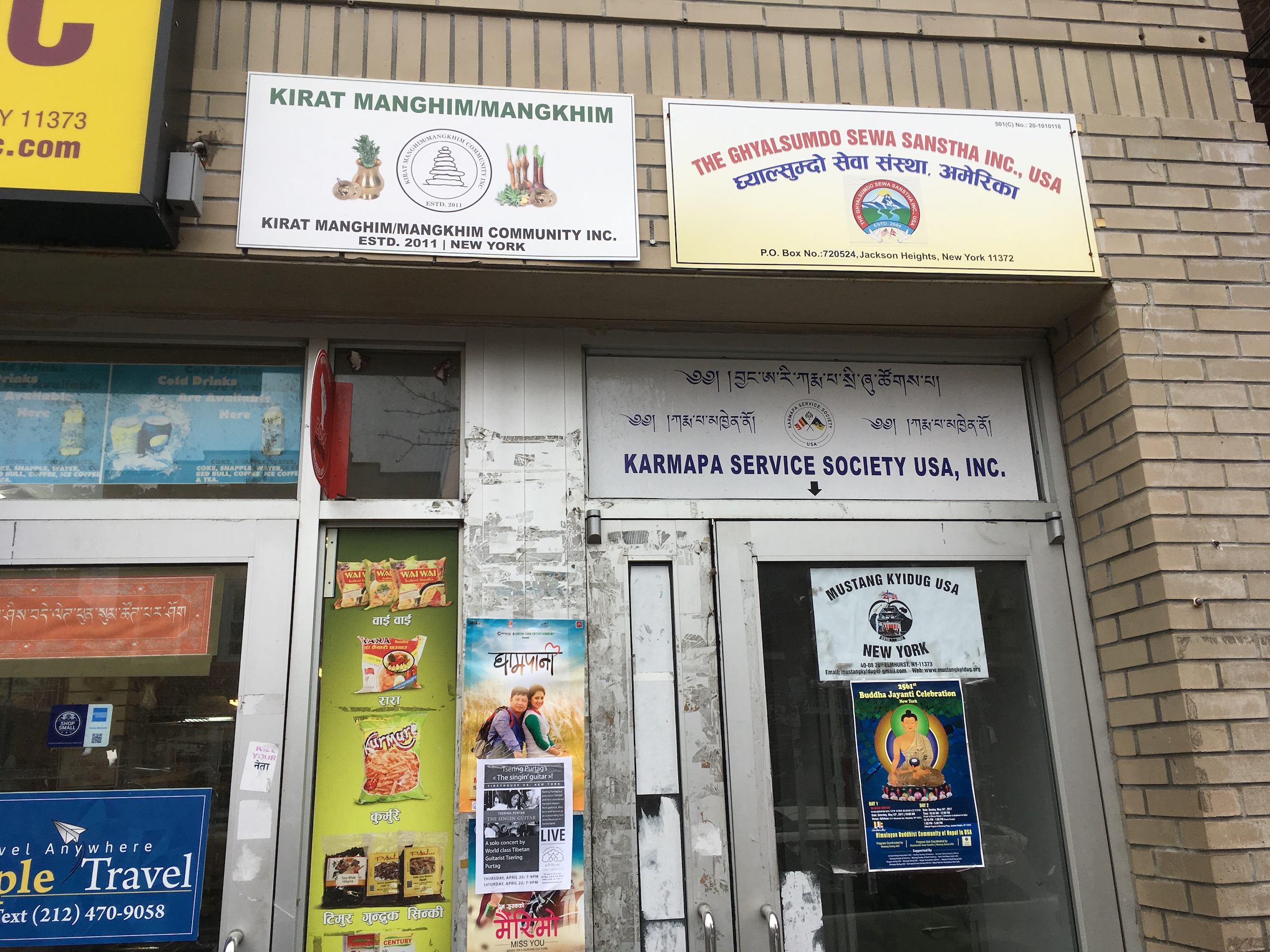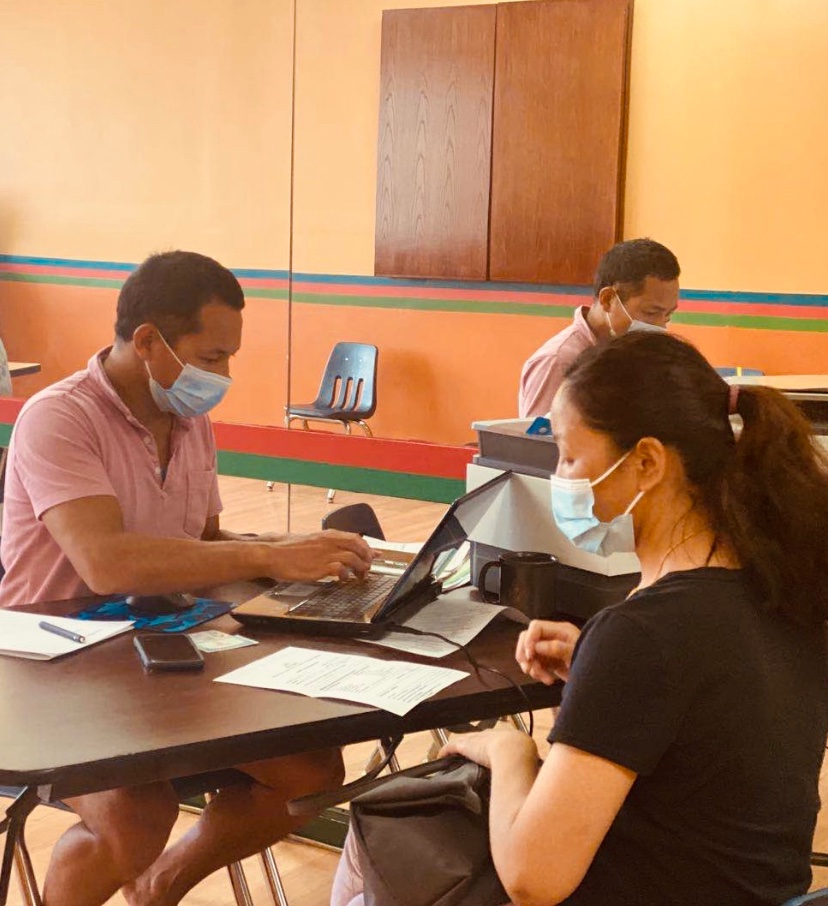They mostly suffered—in some cases, died—at home. Many, as a result, were never tested and will never be included in any official statistics. Those who were accounted for might be grouped as “Asian/Pacific-Islanders,” a Census-derived category far removed from their lived experience, comprised mostly of people from very different backgrounds who far outnumber them. Even within their own community, many chose not to tell others beyond immediate family about their diagnosis, fearing stigma.
At the beginning of late March 2020, New York City became the global epicenter of the Covid-19 pandemic, averaging over 5,000 cases per day. By early April, approximately 500 New Yorkers were dying daily. All nonessential businesses were shut down, and hundreds of thousands of New Yorkers were out of work. No neighborhood was more impacted than those of central Queens, including Corona, Elmhurst, and Jackson Heights, which are home to many immigrant communities and are among the most linguistically diverse areas on Earth.
“Himalayan New Yorkers—clustered in these neighborhoods, enduring overcrowded housing, and working frontline professions—were suddenly at “the epicenter of the epicenter,” even if they remained largely invisible to outsiders.”Himalayan New Yorkers—clustered in these neighborhoods, enduring overcrowded housing, and working frontline professions—were suddenly at “the epicenter of the epicenter,” even if they remained largely invisible to outsiders. In the face of this health, humanitarian, and socioeconomic crisis, community members strategically engaged with governmental systems, claiming visibility as possible, while rapidly developing a response of their own. Even as the pandemic highlighted stark inequalities and the need for a coordinated official response, which came too late for too many, Himalayan New Yorkers harnessed remarkable levels of solidarity and creative self-organization to make it through themselves—and to assist other New Yorkers.
“The message is not spread”
In the last few decades, driven by political repression, climate change, educational aspirations, and economic factors, as many as 50,000 people speaking at least 40 different language varieties have left Tibetan parts of China, Nepal, India, and Bhutan for New York, forming a major new node in an emergent global diaspora of Himalayan peoples.
To document the development of this new community, our partnership team began a video storytelling project, Voices of the Himalaya, in 2016, that recorded oral history interviews in a dozen languages. Subsequent projects have included Songs and Singers of the Himalaya, on vocal traditions transplanted to and now evolving in New York, as well as an ongoing project to document the endangered Seke language, which is spoken in five villages of Nepal and a handful of “vertical villages”—whole communities nested within apartment buildings in New York City. At the same time, with support from the Peter Wall Institute for Advanced Studies at the University of British Columbia, the team has launched a new digital language map of New York, providing information on speakers of some 500 language varieties, including dozens of Himalayan ones, which are invisible in Census and other available public data.
“As the potential impact of Covid-19 on New York’s Himalayan community became clear, qualitative data collection in community languages became a focus for our collaborative research.”As the potential impact of Covid-19 on New York’s Himalayan community became clear, qualitative data collection in community languages became a focus for our collaborative research. Our team began commissioning daily ten-minute audio-diaries, which participants, to whom we provided honoraria for their time, could safely and easily record at home on their phones, at moments of pause or convenience in their lockdown lives. From April through the end of June 2020—the peak period of the first major wave in New York—these 10 diarists from different communities and walks of life recorded over 400 entries in seven different languages, all made public via SoundCloud. Across May and June, project coordinator Nawang Gurung conducted 28 in-depth interviews with a wide range of leaders and activists on the front lines of the community’s response.
Both the diaries and the interviews reveal a community tested by crisis. Few expected the virus to spread widely in the United States. Reliable information in languages other than English, and to a certain extent Spanish, was almost nonexistent at the outset, though there were subsequent attempts, at least in New York City, to translate some basic materials in eight other major languages that are covered by law: Arabic, French, Bengali, Haitian Creole, Korean, Urdu, Yiddish, and Polish.1The Coronavirus Language Access Act, introduced by Queens congresswoman Grace Meng to bring federal support for translation efforts, has languished. On the other hand, there was no lack of misinformation transmitted via WhatsApp and WeChat, a popular social network from China also popular among many Himalayan people. “There was no concrete information in the Tibetan community in Tibetan in March, and I know it wasn’t there in April,” said Yangchen Dolma, an activist with Adhikaar, one of the Queens-based community organizations that scrambled to fill the gap.
Those who shared and those who didn’t
Compounding the lack of official messaging in the community’s languages, many of those affected were at least initially reluctant to share their own experiences. “Instead of getting help,” said Dolma, referring to a sense of stigma, “a lot of people held back and suffered alone, or didn’t get the full help that they should have gotten.” This stigma emerged from several sources, at once cultural, linguistic, and political. The challenge of accessing reliable information in relevant languages about transmission and personal protection against Covid-19 was compounded by the rise in anti-Asian racism surrounding the novel coronavirus, including in New York. Many Himalayan peoples may be presumed to be “Chinese” based on their physical appearance and often work for other Asian Americans as well as South and East Asian immigrant-run businesses; some feared for their jobs, others for their safety. A third layer of stigma was more internal—cultural and familial. Some Himalayan people maintain a strong sensibility that overtly naming illness has the potential to increase an individual’s vulnerability to that illness or invite a negative outcome; so, while people may be cared for, this care is offered quietly, within a very small circle. In other instances, people are reluctant to worry other family members—particularly those living far away—and so do not feel comfortable admitting to sickness until they are on a certain road to recovery. Chhemang Lama, a member of the Tamang community active in aid efforts, agreed: “I found two kinds of people: Those who shared with the community and got more help, and the others [who didn’t].”

The urgency, unfamiliarity, and attendant economic crises that emerged from the pandemic challenged all of this. When those who had contracted Covid-19 began telling their own stories in the tight-knit world of Himalayan social media, the effect was galvanizing. “When people share their experiences, challenges, symptoms and process of recovery,” said Lama, “that helps many in the community face it and tackle it with positive thoughts when they are affected.” The widely reported death of Anil Subba, an Uber driver in Queens originally from an ethnic Limbu area of eastern Nepal, and the social media posts of well-known Tamang videographer Shambhu Moktan (“The world is in trouble, we are in trouble, and I AM IN TROUBLE”) led others to open up publicly, though often only after the worst was over. Nurses like Lhakpa Dolma Sherpa, one of the project diarists, began to do the same. Aska Sherpa is another nurse who had just recovered when she spontaneously shared the news with Facebook friends: “I got a lot of positive responses… I am glad that I decided to share it at that moment.”
The silence of many, however, along with the inadequacy of the city’s statistics, means that accurate morbidity and mortality numbers for this and other communities at the epicenter may never be available. “If we are to count, it is impossible,” said Pema Dorjee, president of the Tibetan Nurses Association (TNA), which includes over 200 members of the approximately 500 Himalayan healthcare workers in the tristate area. “The infection rate is high, but most… don’t show severe symptoms and don’t have to visit the hospital.”
“No one went to the hospital until and unless there was a shortage of breath,” according to Dolkar Lhamo, an out-of-work bartender who threw herself into relief efforts. “Many of our people feared going to the hospital, because they were worried about getting worse due to many infected patients.” In this, they were also following the official guidance to ride things out at home if possible, though for some this had tragic consequences.
Some may have feared going to the hospital for reasons other than contagion. Aska Sherpa, the nurse, reported one of the most harrowing incidents: an encounter with a Covid-19 patient whose hands and feet were tied, apparently because the staff could not understand his language and thought he was not in his right mind. “As soon as I went there, he spoke in Nepali,” said Sherpa. “He didn’t know much English, so he wasn’t able to communicate with the nurses and doctors there”—and he had been unable to hear a phone interpreter.
“So, I was able to go in, ask them to de-escalate, and open up his hands and legs,” said Sherpa. The man was fine and ultimately recovered from Covid-19, but it turned out he had no family in the United States and had become homeless due to the pandemic. “He had come here taking loans,” Sherpa added. “The reason he panicked in the hospital was that he thought that they would send him back to Nepal. So that fear was what made him try to leave the hospital.” Since this is not allowed, it led to the man, ill, anguished, and misunderstood, being restrained.

“Help from all directions”
If such cases were rare, at least among Himalayan New Yorkers, it’s because “on every block in New York City we have our own organizations,” joked Chhemang Lama of the Tamang Society of America. “During this kind of pandemic, people also realized the importance of and need for their own organizations.” Besides crosscutting groups like the TNA, the Himalayan Elders Project, and the Tibetan Community of New York and New Jersey (TCNY), there are dozens of samaj and kyidug, or hometown social service associations, representing individual ethnolinguistic groups—even at the level of a single valley in northern Nepal, for instance, from which there are now 70 people in Queens. “I know how many members we have [in our community],” said Lama, “and you know how many members you have in your own community,” so help can go directly to those who need it. Those with larger memberships, like the Sherpa Kyidug, provide services not just to their members but to the whole Himalayan community, and sometimes beyond.
From such organizations grew more ad-hoc, outward-facing efforts to meet the crisis. Quiet efforts to organize the community and build power in recent years, including a first-ever “Himalayan Town Hall” held in Queens with city officials in 2016, likewise bore fruit. While some Himalayan community organizations, had made efforts to be recognized as communities by city government in the past and gain support for cultural and educational programs, and while work of human, worker, and immigrant rights organizations, such as Adhikaar, were well established, this 2016 forum was a watershed moment in many respects, laying the foundation for more such efforts during the pandemic. Lama and Shyam Karki, another community activist, described efforts of a task force that united an intergenerational spectrum of Nepali New Yorkers with a mission “to get resources and facilities from the state level and city level for our community.” What they describe is a successful form of claiming visibility that is new to many in the community: “We also contacted our senators, council members, local community leaders et cetera”—and this brought resources. At one point, the task force even contacted Maryland state senator Harry Bhandari, the first state-level politician of Nepali origin, to negotiate for the release of the bodies of some deceased, which were being held by a hospital.

Before establishing a similar task force, the Tibetan Community of NY and NJ moved first to fill the linguistic and informational gap, collaborating with the TNA to create an information hotline that served some 250 community members at the height of the first wave. Medical professionals explained in several community languages information available virtually nowhere else “about the disease, what it is, what happens, what to do, the kind of things needed at home,” according to Dorjee of the TNA. The next step for the Himalayan community was to address rising mental health challenges, notably in collaboration with practitioners of Tibetan medicine (sowa rigpa) and Tibetan Buddhism, and to deliver meals to several hundred people. At one point, hundreds of meals were also provided to non-Himalayan first responders.
“Most of the hospitals in Queens have Tibetan medical staff nurses,” said Dorjee of TNA, with others scattered across a dozen hospitals, nursing homes, and rehab centers in the region. “We spread the message around,” added Tenzin Bhakto, a founding member of the TNA. “In this way, if someone [in the Himalayan community] needs to visit the hospital, they can at least stay a little calm because there is at least one Tibetan working in that hospital.” At a time when all visitors were barred, nurses looked out for fellow community members, keeping open a line of communication with family members, organizations, and a rotating group of three monks who made themselves available to perform virtual prayers for and with patients.
Other organizations focused on the economic crisis, given how many community members are recent (sometimes undocumented) immigrants without access to any official safety net. Even those eligible, whether for traditional Unemployment Insurance, the Pandemic Unemployment Assistance program, or housing relief, faced formidable linguistic and bureaucratic hurdles. The New York Tibetan Service Center was one of several community organizations that stepped in. Already at the end of April 2020, Executive Director Tsering Diki reported that the organization had helped around a thousand people file for relief, including via WeChat groups for the unemployed and for small business owners.

Health, information, food, PPE, and housing—so that those quarantining would not infect their relatives, especially elders—were of course central to the community response. But virtual cultural and religious activities have also flourished. “I had never thought about the computer for prayers, but now people use such devices to pray together,” said Lhakpa Gurung, a pre-K teacher and community activist. Diarists and interviewees reported extensive contact with relatives scattered around the globe, as well as intense participation in the virtual dharma teachings that have proliferated over the past year. Hailed as a star by NPR, Tenzin Kalsang, a librarian at the Brooklyn Public Library, launched a bilingual Tibetan-English story time that has attracted tens of thousands of viewers around the world.
Preserving visibility
Whether or not the presence and resilience of Himalayan New Yorkers at the pandemic’s epicenter will render them more visible to their neighbors and to city officials in the longer term remains to be seen. This crisis may have inspired new levels of claims for visibility and support, yet older patterns of reticence, uncertainty, and even invisibility may reemerge as the crisis recedes. It seems likely at least that community leaders will continue to combine existing practices of community-based organizing and advocacy with a newer, outward-facing orientation as it confronts the next set of challenges posed by the pandemic and its impacts on translocal lives and livelihoods—families and communities that circulate between Himalayan villages and the “global village” of New York City.
While the intensity of the pandemic recedes in the United States, Covid-19 is now hitting the greater Himalayan region with grave intensity. The spring 2021 “second wave” across South Asia has re-emphasized the fact that health equity demands that we pay attention to language and culture as they intersect with public health, particularly in marginalized communities. It also means challenging the relative invisibility of countries like Nepal on the global stage: fighting against “vaccine apartheid,” arguing for the grassroots organizing capacities of Himalayan communities to deliver vaccines, and tying such efforts back to the need to address fundamental inequities in health services in New York, based on what was experienced, and what was learned, at the “epicenter of the epicenter” last spring.
Acknowledgements
This research was assisted by the Social Science Research Council’s Rapid-Response Grants on Covid-19 and the Social Sciences, with funds provided by the SSRC, the Henry Luce Foundation, the William and Flora Hewlett Foundation, the Wenner-Gren Foundation, and the MacArthur Foundation. In addition, the authors gratefully acknowledge support for this research from the Peter Wall Institute Wall Solutions Grant (University of British Columbia), the Endangered Language Alliance, and Dartmouth College’s Office of the Provost SPARK Award, and the Claire Garber Goodman Fund, Department of Anthropology, Dartmouth College.
Banner photo by Yeshi Jigme Gangne.














